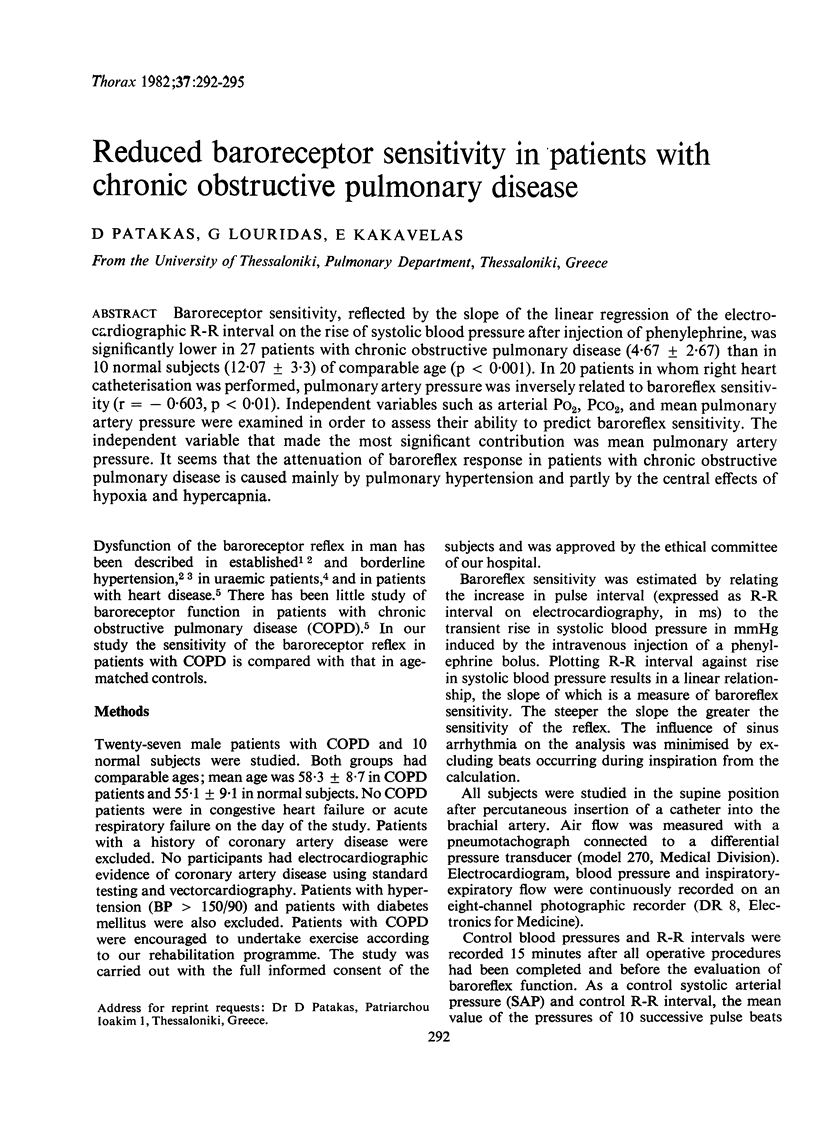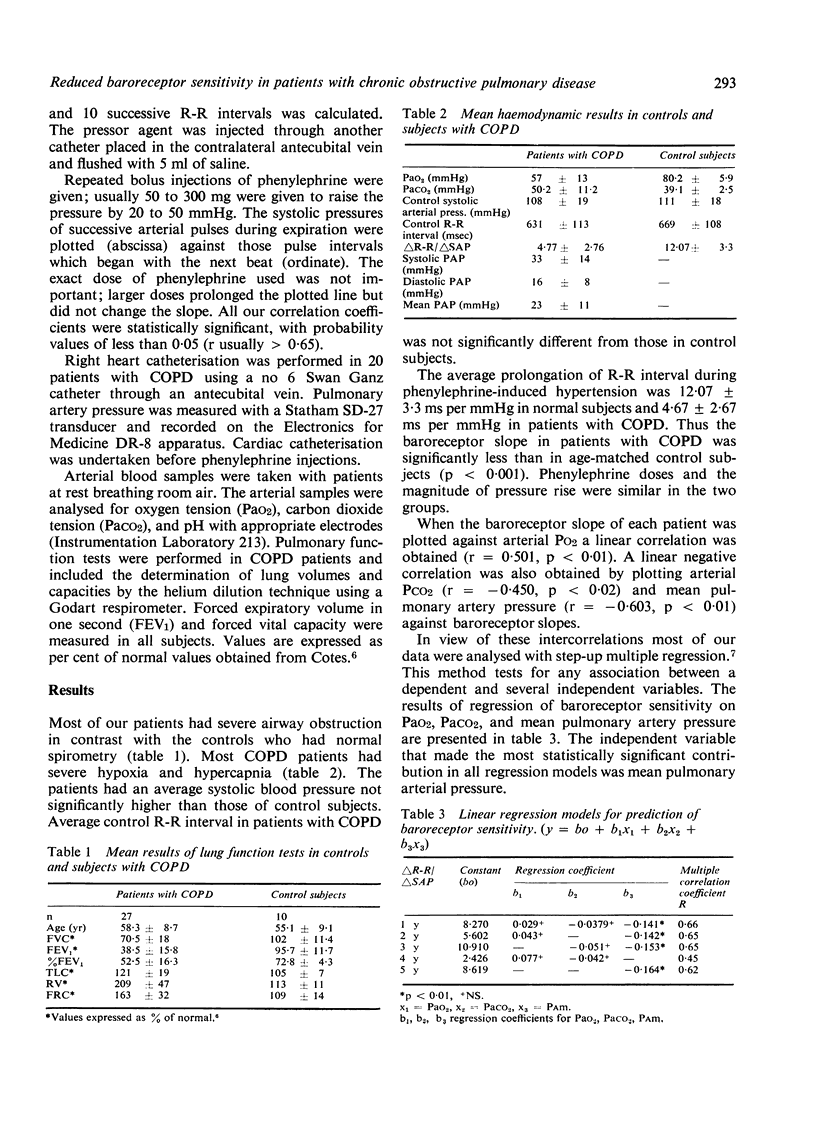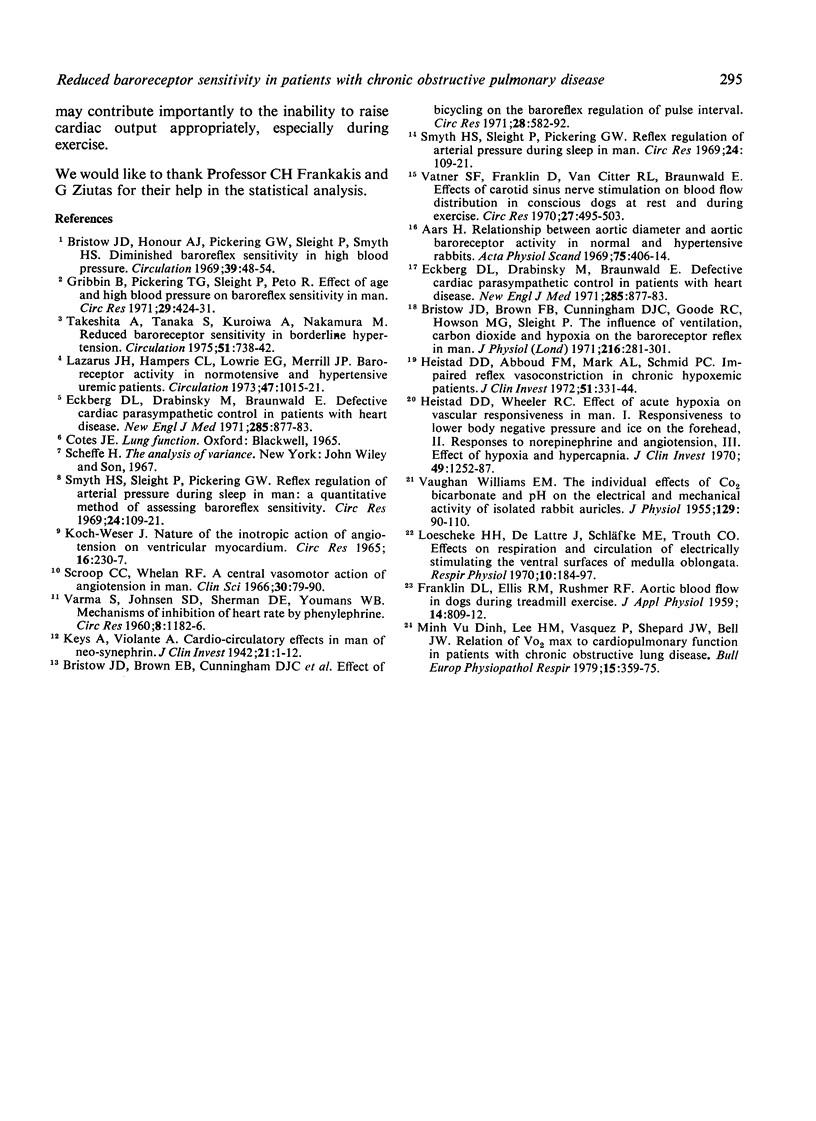Abstract
Baroreceptor sensitivity, reflected by the slope of the linear regression of the electrocardiographic R-R interval on the rise of systolic blood pressure after injection of phenylephrine, was significantly lower in 27 patients with chronic obstructive pulmonary disease (4.67 +/- 2.67) than in 10 normal subjects (12.07 +/- 3.3) of comparable age (p less than 0.001). In 20 patients in whom right heart catheterisation was performed, pulmonary artery pressure was inversely related to baroreflex sensitivity (r = - 0.603, p less than 0.01). Independent variables such as arterial Po2, Pco2, and mean pulmonary artery pressure were examined in order to assess their ability to predict baroreflex sensitivity. The independent variable that made the most significant contribution was mean pulmonary artery pressure. It seems that the attenuation of baroreflex response in patients with chronic obstructive pulmonary disease is caused mainly by pulmonary hypertension and partly by the central effects of hypoxia and hypercapnia.
Full text
PDF



Selected References
These references are in PubMed. This may not be the complete list of references from this article.
- Aars H. Relationship between aortic diameter and aortic baroreceptor activity in normal and hypertensive rabbits. Acta Physiol Scand. 1969 Mar;75(3):406–414. doi: 10.1111/j.1748-1716.1969.tb04394.x. [DOI] [PubMed] [Google Scholar]
- Bristow J. D., Brown E. B., Jr, Cunningham D. J., Goode R. C., Howson M. G., Sleight P. The effects of hypercapnia, hypoxia and ventilation on the baroreflex regulation of the pulse interval. J Physiol. 1971 Jul;216(2):281–302. doi: 10.1113/jphysiol.1971.sp009525. [DOI] [PMC free article] [PubMed] [Google Scholar]
- Bristow J. D., Honour A. J., Pickering G. W., Sleight P., Smyth H. S. Diminished baroreflex sensitivity in high blood pressure. Circulation. 1969 Jan;39(1):48–54. doi: 10.1161/01.cir.39.1.48. [DOI] [PubMed] [Google Scholar]
- Eckberg D. L., Drabinsky M., Braunwald E. Defective cardiac parasympathetic control in patients with heart disease. N Engl J Med. 1971 Oct 14;285(16):877–883. doi: 10.1056/NEJM197110142851602. [DOI] [PubMed] [Google Scholar]
- Eckberg D. L., Drabinsky M., Braunwald E. Defective cardiac parasympathetic control in patients with heart disease. N Engl J Med. 1971 Oct 14;285(16):877–883. doi: 10.1056/NEJM197110142851602. [DOI] [PubMed] [Google Scholar]
- FRANKLIN D. L., ELLIS R. M., RUSHMER R. F. Aortic blood flow in dogs during treadmill exercise. J Appl Physiol. 1959 Sep;14:809–812. doi: 10.1152/jappl.1959.14.5.809. [DOI] [PubMed] [Google Scholar]
- Gribbin B., Pickering T. G., Sleight P., Peto R. Effect of age and high blood pressure on baroreflex sensitivity in man. Circ Res. 1971 Oct;29(4):424–431. doi: 10.1161/01.res.29.4.424. [DOI] [PubMed] [Google Scholar]
- Heistad D. D., Abboud F. M., Mark A. L., Schmid P. G. Impaired reflex vasoconstriction in chronically hypoxemic patients. J Clin Invest. 1972 Feb;51(2):331–337. doi: 10.1172/JCI106818. [DOI] [PMC free article] [PubMed] [Google Scholar]
- Heistad D. D., Wheeler R. C. Effect of acute hypoxia on vascular responsiveness in man. I. Responsiveness to lower body negative pressure and ice on the forehead. II. Responses to norepinephrine and angiotensin. 3. Effect of hypoxia and hypocapnia. J Clin Invest. 1970 Jun;49(6):1252–1265. doi: 10.1172/JCI106338. [DOI] [PMC free article] [PubMed] [Google Scholar]
- KOCH-WESER J. NATURE OF THE INOTROPIC ACTION OF ANGIOTENSIN ON VENTRICULAR MYOCARDIUM. Circ Res. 1965 Mar;16:230–237. doi: 10.1161/01.res.16.3.230. [DOI] [PubMed] [Google Scholar]
- Keys A., Violante A. THE CARDIO-CIRCULATORY EFFECTS IN MAN OF NEO-SYNEPHRIN (1-alpha-hydroxy-beta-methylamino-3-hydroxy-ethylbenzene hydrochloride). J Clin Invest. 1942 Jan;21(1):1–12. doi: 10.1172/JCI101270. [DOI] [PMC free article] [PubMed] [Google Scholar]
- Lazarus J. M., Hampers C. L., Lowrie E. G., Merrill J. P. Baroreceptor activity in normotensive and hypertensive uremic patients. Circulation. 1973 May;47(5):1015–1021. doi: 10.1161/01.cir.47.5.1015. [DOI] [PubMed] [Google Scholar]
- Loeschcke H. H., De Lattre J., Schläfke M. E., Trouth C. O. Effects on respiration and circulation of electrically stimulating the ventral surface of the medulla oblongata. Respir Physiol. 1970 Sep;10(2):184–197. doi: 10.1016/0034-5687(70)90082-4. [DOI] [PubMed] [Google Scholar]
- Minh V. D., Lee H. M., Vasquez P., Shepard J. W., Bell J. W. Relation of VO2max. to cardiopulmonary function in patients with chronic obstructive lung disease. Bull Eur Physiopathol Respir. 1979 Mar-Apr;15(2):359–377. [PubMed] [Google Scholar]
- Scroop G. C., Whelan R. F. A central vasomotor action of angiotensin in man. Clin Sci. 1966 Feb;30(1):79–90. [PubMed] [Google Scholar]
- Smyth H. S., Sleight P., Pickering G. W. Reflex regulation of arterial pressure during sleep in man. A quantitative method of assessing baroreflex sensitivity. Circ Res. 1969 Jan;24(1):109–121. doi: 10.1161/01.res.24.1.109. [DOI] [PubMed] [Google Scholar]
- Smyth H. S., Sleight P., Pickering G. W. Reflex regulation of arterial pressure during sleep in man. A quantitative method of assessing baroreflex sensitivity. Circ Res. 1969 Jan;24(1):109–121. doi: 10.1161/01.res.24.1.109. [DOI] [PubMed] [Google Scholar]
- Takeshita A., Tanaka S., Kuroiwa A., Nakamura M. Reduced baroreceptor sensitivity in borderline hypertension. Circulation. 1975 Apr;51(4):738–742. doi: 10.1161/01.cir.51.4.738. [DOI] [PubMed] [Google Scholar]
- VARMA S., JOHNSEN S. D., SHERMAN D. E., YOUMANS W. B. Mechanisms of inhibition of heart rate by phenylephrine. Circ Res. 1960 Nov;8:1182–1186. doi: 10.1161/01.res.8.6.1182. [DOI] [PubMed] [Google Scholar]
- VAUGHAN WILLIAMS E. M. The individual effects of CO2, bicarbonate and pH on the electrical and mechanical activity of isolated rabbit auricles. J Physiol. 1955 Jul 28;129(1):90–110. doi: 10.1113/jphysiol.1955.sp005340. [DOI] [PMC free article] [PubMed] [Google Scholar]
- Vatner S. F., Franklin D., Van Citters R. L., Braunwald E. Effects of carotid sinus nerve stimulation on blood-flow distribution in conscious dogs at rest and during exercise. Circ Res. 1970 Oct;27(4):495–503. doi: 10.1161/01.res.27.4.495. [DOI] [PubMed] [Google Scholar]


